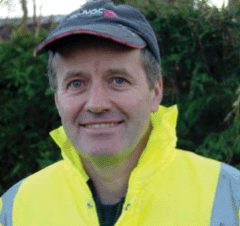



Finisher Challenge Champion
BPEX Farm Case Study no. 36 'Improving finisher herd performance' describes how three management changes made by a farmer in Essex improved the growth rate, feed conversion and mortality in the finishing unit.
Background
Producer Chris Leamon got in touch with the BPEX knowledge transfer team to sign up to the 2TS Finisher Challenge. He was already working with his vet to improve his feeding herd health status, in particular to reduce the high level of mortality in his finisher pigs.
The main health problem was porcine dermatitis and nephropathy syndrome (PDNS), with finisher pig mortality rates running at around eight per cent. At its worst, the herd was losing 50 pigs per month in the post-50kg stage - not only a huge financial loss but also disheartening for Chris and the staff. Pigs are finished at 102kg liveweight.
Farm Facts
- Name: A. and B. Leamon
- Location: Essex
- Farm size and type: 320-sow indoor breed-to finish unit
The System
Chris introduced three key changes during the first half of 2012:
- In January, he improved pig flow by reducing the number of movements post-weaning
- From the spring, he started vaccinating sows as well as piglets with a PCV2 vaccine
- In late summer, he started selling lighter pigs with the rest of the batch rather than keeping poor growers back to reach target weight.
Benefits
- Finisher herd mortality reduced from 8.9 per cent to 6.8 per cent
- Finisher herd FCR improved from 3.13 to 2.37
- Finisher herd daily growth rate increased from 555g to 620g
- Stress is reduced due to improved pig flow with fewer movements
- The all-in, all-out system enables cleaning and disinfection of all rooms between batches
- Chris Leamon was the national winner of the 2TS Finisher Challenge in 2012.

Key to Success
- Mr Leamon reduced the number of movements post-weaning, from four moves down to two, for most pigs
- All pigs remain in the same group from weaning through to slaughter
- Selling poor-growing, lighter pigs with the rest of the batch, rather than keeping them back, has led to health improvements in the later finishing stages
- Four different diets are fed between weaning and finishing
- With two feed pipelines coming into the sheds, Mr Leamon uses a phase feeding programme switching diets gradually on a daily basis.
Further Reading
Find out more information on porcine dermatitis and nephropathy syndrome (PDNS) by clicking here.
May 2013








